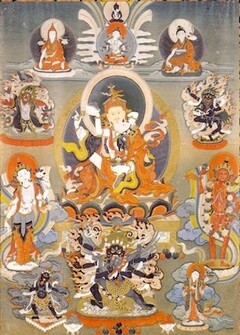Longchen Nyingtik Gektor
༄༅། །བགེགས་གཏོར།
The Torma for the Obstructing Forces (Gektor)
according to the tradition of Dodrupchen Monastery
བགེགས་གཏོར་ལ། ལས་བུམ་བདུད་རྩི་འཁྱིལ་བ་བསྒྲུབས་ཡོད་ན།
If you have blessed the activity vase with Amṛtakuṇḍalī, recite the following mantra:
ཨོཾ་བཛྲ་ཨ་མྲྀ་ཏ་ཀུཎྜ་ལི་ཧ་ན་ཧ་ན་ཧཱུྃ་ཕཊ྄ཿ
om benza amritakundali hana hana hung pé
oṃ vajra amṛtakuṇḍali hana hana hūṃ phaṭ
མེད་ན།
If you have not, recite:
ཨོཾ་བཛྲ་ཀྲོ་དྷ་ཧྱ་གྲཱི་ཝ་ཧཱུྃ་ཕཊ྄༔
om benza krodha hayagriva hung pé
oṃ vajra krodha hayagrīva hūṃ phaṭ
ཨོཾ་སྭ་བྷཱ་ཝ་ཤུདྡྷཱཿསརྦ་དྷརྨཱཿསྭ་བྷཱ་ཝ་ཤུདྡྷོ྅་ཧཾ།
om sobhava shuddha sarva dharma sobhava shuddho hang
oṃ svabhāva śuddhāḥ sarva dharmāḥ svabhāva śuddho ’haṃ
སྟོང་པ་ཉིད་དུ་གྱུར།
tongpanyi du gyur
Everything dissolves into emptiness.
སྟོང་པའི་ངང་ལས་རིན་པོ་ཆེའི་སྣོད་ཀྱི་ནང་དུ་བགེགས་ཀྱི་གཏོར་མ་གཟུགས་སྒྲ་དྲི་རོ་རེག་བྱ་ཕུན་སུམ་ཚོགས་པ་བདུད་རྩིའི་རྒྱ་མཚོ་ཆེན་པོར་གྱུར།
tongpé ngang lé rinpoche nö kyi nang du gek kyi torma zuk dra dri ro rekja pünsum tsokpa dütsi gyatso chenpor gyur
From the state of emptiness arises a precious vessel containing the torma for the obstructing forces, which transforms into a great ocean of amṛta endowed with perfect form, sound, fragrance, taste and touch.
ཨོཾ་ཨཱཿཧཱུྃ། ཨོཾ་ཨཱཿཧཱུྃ། ཨོཾ་ཨཱཿཧཱུྃ་ཧོ།
om ah hung | om ah hung | om ah hung ho
oṃ āḥ hūṃ | oṃ āḥ hūṃ | oṃ āḥ hūṃ ho
Recite three times:
སརྦ་བྷཱུ་ཏ་ཨཱ་ཀརྵ་ཡ་ཛཿ ལན་གསུམ།
sarva bhuta akarshaya dza
sarva bhūta ākarṣaya jaḥ
Offer the torma by reciting three times:
ཨོཾ་སརྦ་བིགྷྣཱན་ན་མཿསརྦ་ཏ་ཐཱ་ག་ཏེ་བྷྱོཿབི་ཤྭ་མུ་ཁེ་བྷྱཿསརྦ་ཐཱ་ཁཾ་ཨུདྒ་ཏེ་སྥ་ར་ཎ་ཧི་མཾ་ག་ག་ན་ཁཾ་གྷྲྀཧྞེ་དཾ་བ་ལིཾ་ཏ་ཁ་ཁ་ཁཱ་ཧི་ཁཱ་ཧི་སྭཱ་ཧཱ། ལན་གསུམ་གྱི་མཐར།
om sarva bighanen nama sarva tatagaté bayo bisho mukhebé sarva takham udgaté saparana imam gagana kham grihanen idam balingta kha kha khahi khahi soha
oṃ sarva vighnān namaḥ sarva tathāgate bhoḥ viśva mukhebhyaḥ sarvathā kham udgate spharaṇa imaṃ gagana khaṃ gṛihnedaṃ balim te kha kha khāhi khāhi svāhā
Then continue with the torma offering to the obstructing forces in the main text.
ཧྲཱིཿ སྣོད་བཅུད་སྤྲུལ་པའིསོགས་རང་གཞུང་གི་བགེགས་གཏོར་ལ་འཇུག
hrih, nöchü trulpé
Hrīḥ. In this manifesting maṇḍala of the environment and beings…
At the end, recite the mantra of the four hūṃs:
མཐར་ཨོཾ་སུཾ་བྷ་ནི་སུཾ་བྷ་ནི་ཧཱུྃ༔ གྲྀ་ཧྣ་གྲྀ་ཧྣ་ཧཱུྃ༔ གྲྀ་ཧྣ་པཱ་ཡཿགྲྀ་ཧྣ་པཱ་ཡཿཧཱུྃ༔ ཨཱ་ན་ཡ་ཧོ༔ བྷ་ག་ཝན་བིདྱཱ་རཱ་ཛ་ཀྲོ་དྷ་ཧཱུྃ་ཕཊ྄༔ ཅེས་ཧཱུྂ་བཞིའི་སྔགས་དང་།
om sumbhani sumbhani hung | grihana grihana hung | grihanapaya grihanapaya hung | anaya ho | bhagawan bidyaraza krodha hung pé
oṃ sumbhani sumbhani hūṃ | gṛhṇa gṛhṇa hūṃ | gṛhṇāpaya gṛhṇapaya hūṃ | ānaya hoḥ bhagavan vidyārāja krodha hūṃ phaṭ
And the wrathful thirty-five-syllable mantra:
ཨོཾ་བཛྲ་མ་ཧཱ་ཀྲོ་དྷ་པདྨ་ཀྲོ་དྷི་ཤྭ་རི་བཛྲ་ཀཱི་ལི་ཀཱི་ལ་ཡ་མ་ཧཱ་ཡ་ཀྵ་ཀཱ་ལ་རུ་པ་ཀརྨཱ་རཾ་རཾ་ཛྭ་ལ་རཾ་ཧཱུྃ་ཕཊཿ ཅེས་དྲག་སྔགས་སོ་ལྔ་པའི་མཐར།
om benza mahakrodha pema krodhishori benzakili kilaya mahayaksha kalarupa karma ram ram dzola ram hung pé
oṃ vajra-mahākrodha padma-krodhi-śvari vajra-kīli kīlaya mahāyakṣa kālarūpa karma raṃ raṃ jvala raṃ hūṃ phaṭ
གནོད་བྱེད་བགེགས་ཚོགས་ལོག་པར་འདྲེན་པའི་ཚོགས་ཐམས་ཅད་སརྦ་ཨུཙྪི་ཥྚ་ཡ་ཕཊ།
nöjé gek tsok lokpar drenpé tsok tamché sarva utsitaya pé
All the hosts of harmful, obstructing forces and misleading influences are annihilated without a trace! Sarva ucchiṣṭaya phaṭ.
ཅེས་བགེགས་བསྐྲད།
With this, expel the obstructing forces.
དེ་ནས
Then continue with:
ཧྲཱིཿ སྣང་སྲིད་དག་པ་སོགས་རང་གཞུང་གི་སྲུང་འཁོར་ལ་འཇུག་པ་ཀུན་ལ་འགྲེ།།
hrih, nangsi dakpa...
Hrīḥ. In the infinite purity of appearance and existence… etc.
Carry out the protective circle of the main text. This is the same for all the other sādhanas.
ཡུམ་ཀ་ལ་རྡོར་དྲིལ་བྱིན་རླབས་མཇུག་སྔོན་གཏོར་བཏང་། བསྲུང་འཁོར་རྗེས་སྐྱབས་ཡུལ་གསལ་གདབ། སྐྱབས་སེམས་སོགས་གཞུང་བཞིན་འཇུག་པ་རྡོ་གྲུབ་ཆེན་གྱི་ཕྱག་བཞེས་སོ༎ ༎
However, for the Female Practice of the Queen of Great Bliss (Yumka Dechen Gyalmo), you should offer the preliminary torma at the end of blessing the vajra and bell. After meditating on the protection circle, visualize the field of merit, and then recite the refuge, bodhicitta, and so on. This is the tradition of Dodrupchen.1
| Translated by Han Kop with the kind assistance of Tulku Dawa, 2016. With thanks to Stefan Mang. Edited for the Longchen Nyingtik Project, 2024.
Source:
bgegs gtor" in klong chen snying thig gi 'don cha rtsa gsum tshogs bskang skor. Gangtok, Sikkim: mChod rten dgon pa, 2016, pp. 109–110.
Version: 1.0-20240507
- ↑ Tulku Dawa says that this means the tradition of all the Dodrupchen Rinpoches and Dodrupchen Monastery.
